Excerpts from Jim Conrad's
Naturalist Newsletter
from the March 2, 2014 Newsletter issued from the Frio Canyon Nature Education Center in the valley of the Dry Frio River in northern Uvalde County, southwestern Texas, on the southern border of the Edwards Plateau; elevation ~1750m (~5750 ft); N29.62°, W99.86°; USA
GREEN FELT BESIDE THE SEEP
To find unusual organisms it's helpful to look in unusual environments. The slightly unusual environment I visited that day was a small seep where the Dry Frio's waters emerged from the edge of a gravel deposit completely damming the little river. With the river's water as low as it is now, maybe most of the bed consists of dry gravel, but water still flows down the river, just filtering through one gravel barrier after another.
At this particular seep at first glance nothing looked special, except maybe for a small colony of filamentous alga or cyanobacteria at the water's edge. When I poked the green pad with a finger it was fairly firm, not soft and spongy like similar algal mats and rafts on and in the water. If felt like nudging a short-haired, fat, wet mouse. You can see what that looked like below:
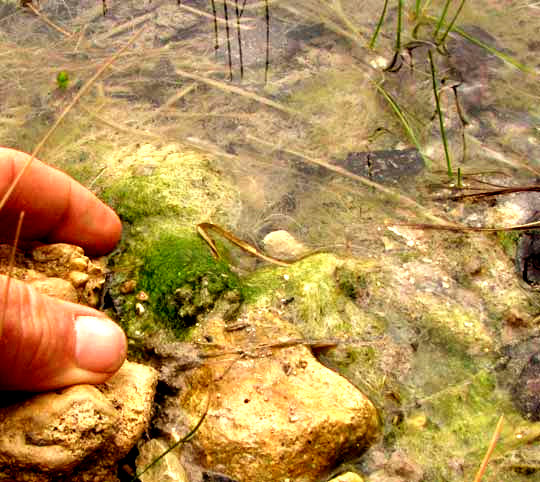
On hands and knees the hand lens displayed structures unlike I'd seen in any alga or cyanobacteria so far. On Y-shaped structures projecting from the filaments' sides were innumerable spore-like items so small that they were hardly visible, as shown below:
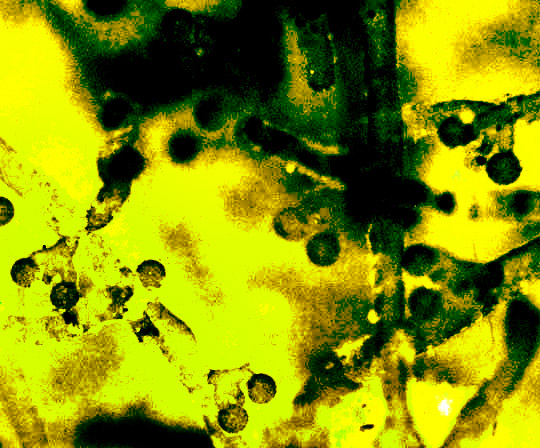
Having collected some filaments, back at Juniper House the microscope showed that the filaments weren't as straight and regularly formed as other filamentous organisms we've seen, nor were individual cells apparent, as has been the case with all the green, filamentous algae we've looked at so far. You can see a filament with calcite crystals adhering to it below:
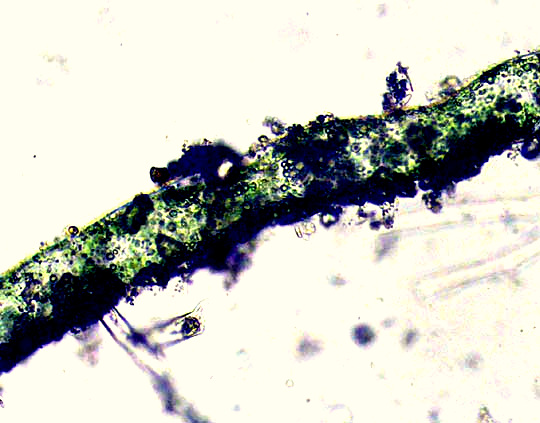
A closer view showing individual green chloroplasts suspended in cytoplasm unrestrained by cell walls is seen below:
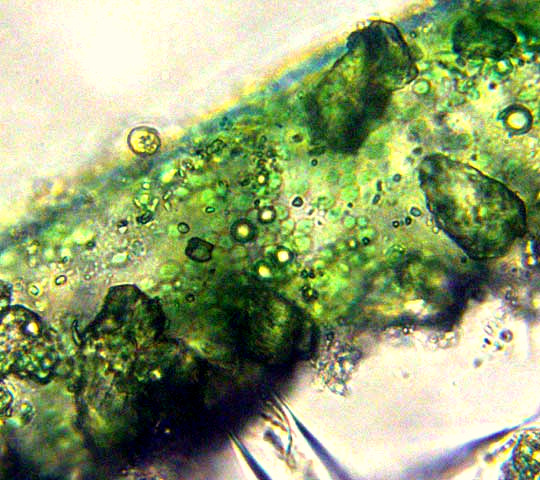
The lack of cell walls suggested that it was a cyanobacterium, not an alga. However, cyanobacteria we've seen so far have been encased in gelatinous sheathes, and these filaments didn't seem to be. Much more disorienting, however, were those spores held at the tips of the Y-shaped items branching from the filaments' sides; spores we've seen produced by both filamentous algae and cyanobacteria have been produced inside cells forming the filaments, or in conjugation tubes between adjacent filaments. A close-up of one of those strange Y-shaped branches bearing a spore at the tip of each branch is shown below:
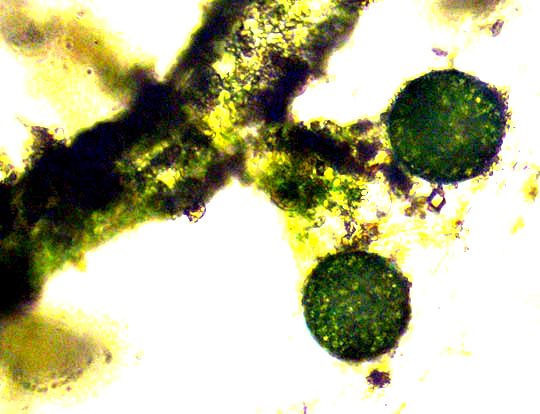
Once again we've found something so unusual that it isn't represented on the usual freshwater-organism identification webpages, and I hardly knew where to begin to identify it. Once again I was reduced to browsing thousands of search-engine-generated thumbnails before finding a picture of something similar.
Our organism is a member of the genus Vaucheria, probably VAUCHERIA GEMINATA, sometimes appropriately known as green felt. The species occurs spottily worldwide and is described as a freshwater/terrestrial species, which applies well to the muddy pool edge where we found it, its top part barely emerging above the water's surface. Ecologically green felt is thought of as a stabilizer of exposed mud.
It's true that green felt's filaments lack the obvious cells with cell walls we've seen among the algae. Green felt species are "coenocytes." Coenocytes are organisms composed of a mass of protoplasm containing several nuclei that divide without the kind of cell division seen among regular green algae. Green felt filaments are occupied with large central vacuoles -- vacuoles being bags of water containing enzymes and more -- pushing against the surrounding cytoplasm and extending along the entire length of the filaments, except for the growing tips. Chloroplasts are located on the periphery of the cytoplasm with the nuclei gathering toward the center near the vacuole.
But, what kind of organism is green felt? In the old days green felt was regarded as a plant, and an alga. Nowadays some experts place it in a whole separate kingdom from that of plants, recognized only in 2005, the Chromalveolata. The Chromalveolata includes species descended from an organism consisting of one cell with a nucleus, known as a "bikont," which assimilated into its body a species of red alga, thus forming a symbiotic relationship similar to what we saw with the Green Paramecium a while back, which symbiotically carries photosynthesizing algal cells within it. In fact, experts just aren't sure how to classify it.
The novelty of being placed in a different kingdom from, say, the common Spirogyra alga in our Dry Frio, is that it means that the difference between green felt and Spirogyra is approximately that of the difference between a horse and an oak tree, which also are in different kingdoms.